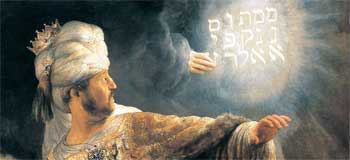Man's Creative Offerings
Why then were there temple vessels which could cause such a philosophical misconception among Jews and gentiles alike? The answer lies in the fact that man was created in the image of God. God's role as a creator is reflected in the creativity of man.
In Genesis, six days of creation were followed by the creation of the day of rest, the Sabbath. In the Book of Exodus we learn of six other days that were followed by a special seventh day:
The Presence of the Lord abode on Mount Sinai, and the cloud hid it for six days. On the seventh day, He called to Moses from the midst of the cloud...'Tell the Israelite people to bring Me gifts; you shall accept gifts for Me from every person who heart so moves him. And these are the gifts that you shall accept from them: gold, silver, and copper; blue, purple...And let them make Me a sanctuary that I may dwell among them.' (Exodus 24:15-16, 25:1-9)
On the seventh day, Moses was instructed regarding the construction of the Sanctuary and its vessels. The parallel is so striking that the Rabbis determined that the kinds of labor prohibited on the Sabbath were all those acts necessary for the construction and furnishing of the Sanctuary in the desert. Man's royal privilege to create, to pursue aesthetic perfection and technical virtuosity, found expression in the crafting of the sacred vessels for use in God's sanctuaries. The vessels themselves were a form of offering. They were not merely receptacles for libations and sacrificial offering; they were inherently holy, having been consecrated to God by man, as an expression of his divine spark - his tzelem elohim - and as a form of thanksgiving.
Therefore, when Belshazzar defiled the sacred temple vessels by secular use, he violated the relationship of the people of Israel with their ancestral God. It was this which signaled an important turning point in Jewish history. When Belshazzar dislodged the spirit from the vessels where it was hiding, it openly revealed itself on the whitewashed wall from where it could never be erased, portending the end of Babylonian Empire and the return of the vessels and the people to where they belonged.

